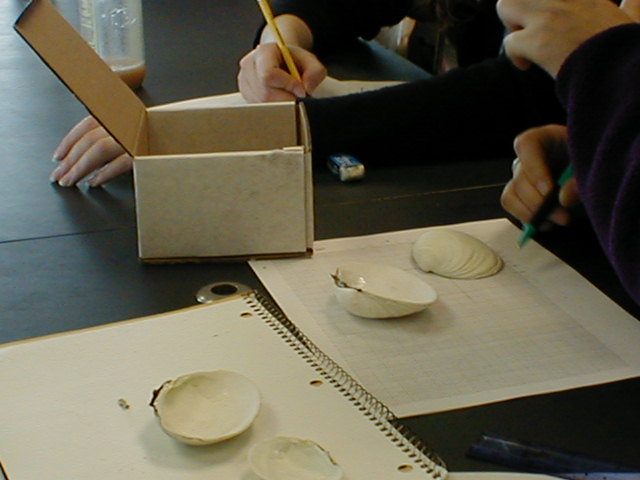Description:
Puget Sound Butter Clams
We've collected a sample of shells of the native butter clam, Saxidomus giganteus (S. is the genus and giganteus is the specie of this bivalve). The butter clam is recognizable because of concentric rings only (no radial lines) and it's robust white shell. The heavy ridges that stand out from the shell represent slow winter growth. Butter clams can grow to lengths of 12-13 cm and live for more than 20 years.

Saxidomus giganteus: Note the robust shell and heavy ridges, with no radial lines.
The butter clam lives on protected (not open ocean) gravelly beaches, such as those found commonly in Puget Sound, burrowing up to a foot or more deep. Butter clams have been an important food source for Native and immigrant Americans; in 1980, about 200,000 pounds of butterclams were harvested (commercially) in Puget Sound, mostly by dredging of the subtidal zone.
Many of our shells have a hole near the hinge. These holes were drilled into the butter clam shells, while the clams were alive, by either the Japanese oyster drill (Ocenebra japonica) or the enormous, native moon snail (Polinices lewisii). These two carnivorous snails use a file-like object called a radula to drill the hole, releasing the suction holding the butter clam shells together, then push their way into the butter clam and eat it. The Japanese oyster drill, a small snail about an inch long, was imported accidentally from Japan along with Japanese oysters earlier in this century. Humans are also an important predator in the intertidal zone. Commensal crabs often are found living inside the shells of (living) butter clams.
The Sample
Our sample (n = 88) was collected from a 100 m stretch of intertidal gravelly beach at Alki Point in west Seattle during November 1998. We did not sample randomly; rather, we picked up every shell at first, then looked for really small shells to make the range in sizes greater. We did not sample whole live butter clams (but lots of people do!), just shells of clams that had died naturally or been killed by predators (snails, humans) or environmental conditions. We assume that the shells are representative of the organism as a whole, but this assumption could be false. We also assume that shells of dead clams are similar to shells of live clams; this assumption seems reasonable. So we assume that sampling the shells of dead clams is basically the same as sampling live clams; the shells are a substitute or proxy for the live clams. Our sample of 88 butter clam shells is a very small subset of the population of live butter clams at Alki Point. Over a 100 m stretch of beach, there must be 1,000-10,000 butter clams in the intertidal zone alone, and many more out below low tide.
Students in our environmental mathematics course at Seattle Central Community College measured the lengths and widths of each shell in our sample. Our shells were disarticulated (broken apart) so that students could measure one-half of each shell pair. Students laid the shells on metric-ruled graph paper to more easily measure length and width at right angles to one another. See photos below.
